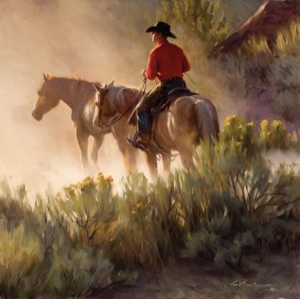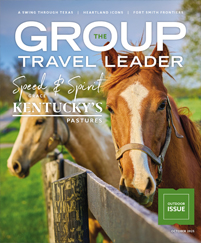
Courtesy National Cowboy and Western Heritage Museum
A new statue that was dedicated in late July on the grounds of the National Cowboy and Western Heritage Museum in Oklahoma City is called Code of the West.
“It shows two cowboys on horseback facing each other, shoulder to shoulder, reaching over shaking hands,” said Leslie Baker, director of marketing for the center. “It speaks to the code of the West, when a handshake was your bond. It’s about as cowboy as you can get.”
In addition to sculptures, cowboys have been depicted in a variety of ways over the years, from the novels of Zane Grey and Louis L’Amour and the paintings of Charlie Russell and Frederic Remington to the movies of director John Ford.
Although the reality of a working cowboy may be a hot, dusty, dangerous and often tedious existence, the cowboy mystique holds a continuing fascination for Americans.
There are many attractions where groups can explore the mythical and the real cowboy, from Smithsonian-quality museums to living-history sites.
National Cowboy and Western Heritage Museum
Oklahoma City
The multifaceted center deals with the history and image of the cowboy in many ways. “In our galleries, we have the cow trail, the modern ranch, rodeo and movie cowboys,” said Baker.
The American Cowboy Gallery provides an extensive and authentic look at the history and culture of the working cowboy in the United States. A re-created, rough-hewn ranch building has exhibits about the development of equipment such as saddles, bits and spurs.
The 4,000-square-foot Western Performers Gallery explores the ways the West has been interpreted in literature and film and includes a large collection of John Wayne memorabilia and clips of films in a re-created 1930s movie theater.
Prosperity Junction is a replica of an early-20th-century cow town complete with two-story structures beneath a 40-foot ceiling, and the American Rodeo Gallery traces the history of the cowboy sport.
The center also has extensive art galleries, a Native American gallery and a firearms gallery.
www.nationalcowboymuseum.org
405-478-2250
Old Tucson Studios
Tucson, Ariz.
Many people’s images of cowboys evolved from the movies and television. And many of those movies and shows were shot on the set at Old Tucson Studios in the Sonoran Desert near Tucson.
Originally built in 1930s and added to over the years, the replica of 1860s Tucson has been the site for films from “The Last Roundup” with Gene Autry to four movies starring Wayne: “Rio Bravo,” “McClintock,” “El Dorado” and “Rio Lobo.”
Visitors might also recognize the town from television’s “Little House on the Prairie” and “Gunsmoke.”
“It’s like a Western theme park,” said Kimberly Schmitz, public relations director for the Tucson Convention and Visitors Bureau. “It’s known as Hollywood in the desert.
“It focuses on the movie cowboy life. It’s not a lot about real cowboys’ life but how Hollywood depicted it. It looks exactly like you see in the movies. It is very dusty and very authentic. It’s like being placed right in those movies and episodes.”
In addition to the possibility of watching the filming of a television show or movie, visitors to Old Tucson Studios can see regular gunfights and stunt shows and a cancan musical in the town’s saloon.
The buildings are more than fake fronts, and many are filled with Western artifacts. One houses a museum with costumes worn by some of the stars who have filmed there, such as Jimmy Stewart, Burt Lancaster, Kirk Douglas, Glenn Ford, Paul Newman, Robert Mitchum, Frank Sinatra, Charleton Heston, Gene Hackman, James Garner, Russell Crowe, Leonardo DiCaprio and Elizabeth Taylor.
Groups can get a 30-minute guided tour.
www.oldtucson.com
520-883-0100, ext. 281
World Championship Ranch Rodeo
Amarillo, Texas
For a look at real working cowboys, head to the World Championship Ranch Rodeo in Amarillo, Nov. 11-14.
“It features real cowboys,” said Eric Miller, director of communications for the Amarillo Convention and Visitors Bureau. “If you want to see the genuine article, these guys are the genuine article.
“Professional rodeos are performers who specialize in those events. In ranch rodeo, the cowboys currently are working on a ranch. Once the event is over on the 14th, they will get in their trucks and drive back, and on the 15th or 16th, they will be back in the saddle doing what they do.”
Miller said the events at ranch rodeos, which are held throughout the year, culminating in the world championship at the Amarillo Civic Center, are also significantly different than those at professional rodeos.
“For ranch rodeo, events are based on actual activities conducted on the ranch, real cowboys doing what real cowboys do on a ranch,” he said. “A real cowboy won’t ride a bull.”
However, Miller said there are bucking horses. “You do try to break horses, and there is a branding event that mimics what goes on during branding season.
“They have a penning event, because cowboys are always trying to separate small groups of cattle out of the bigger herd and pen them, and one of the funniest ones is wild-cow milking. Out in the wild, once in a while, you have to milk a mother cow. It requires quite a bit of effort.”
The rodeo competition is held at night. During the day, there is a trade show with high-end jewelry and Western wear. “It is where the cowboys go to get a new hat or order a saddle,” said Miller. “It is open to the public.”
www.wrca.org
www.visitamarillotx.org
Cheyenne Frontier Days
Cheyenne, Wyo.
One of the biggest draws for professional rodeo, where they do ride bulls, is the Cheyenne Frontier Days, held in Wyoming’s largest city and state capital every July since 1897.
The 10-day event, which proudly calls itself the “Daddy of ’em All,” includes four large parades, free pancake breakfasts that feed thousands, an exhibit hall filled with Western wear for sale, a carnival and midway, a Native American village, living-history demonstrations and big-name rock and country concerts at the 83-acre Frontier Park.
The U.S. Air Force Thunderbirds precision flying team is a regular performer. “We were the first air show they did back in 1956, and we are the only air show they do every year,” said Rod Hottle, Frontier Days general chairman.
But it’s the nightly rodeos, where up to 1,800 top professional rodeo performers compete for nearly $1 million in prize money in steer wrestling, steer and calf roping, saddle and bareback bronc riding, bull riding, barrel racing and team roping, that are the big draw.
“We are the largest outdoor rodeo in the world,” said Hottle. “I refer to it as the first economic stimulus package for Cheyenne. It was founded in 1897 to bring people and tourism to the community.
“Many of the same things that were done back in the early days we still do as competitions.”
One of the more unusual events is a wild-horse race. “A team takes a wild horse, and the challenge is to get a saddle on it and put a rider on it and ride it around the track and beat other teams that are trying to do the same thing,” said Hottle.
Although the rodeo begins on Saturday, there are preliminary competitions, called slack earlier in the week to cut down the entries.
George Ranch Historical Park
Richmond, Texas
The George Ranch Historical Park is part of a 23,000-acre working ranch that passed through four generations of the same family, beginning in 1824, when Texas was part of Mexico.
The 498-acre historical park, which centers around the original homestead, depicts Texas ranching in various eras — the 1830s, the 1860s, the 1890s and the 1930s — with living-history demonstrations and hands-on activities.
Cowboys in period clothing work cattle in the original pens and send them into one of the few dipping vats still operating in the United States, a cook describes the last days of cattle drives while preparing food at an authentic chuck wagon, and a blacksmith demonstrates his trade making most of the metal tools and equipment needed on the ranch.
In the 1830s pioneer area, visitors can try their hand at spinning and weaving, grinding corn and churning butter.
The George Ranch Historical Park has two original houses, the 1890s Victorian mansion and the 1930s George Ranch House, home to the last family members to operate the ranch, who created the foundation that owns it today. Both have original furnishings.
In addition, there are two replica houses around a 1-mile circle: the 1830s Jones Stock Farm dogtrot cabin and the 1860s Ryon Prairie Home.
Groups can arrange for guided tours and meal packages. Also, historical lunches are held each Saturday and rotated through five historic venues.
For more Western attractions:
As cowboy as you can get
Western art has an eternal quality
Poetry at day’s end









